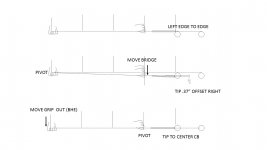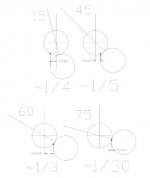Edge of the cue ball (CB) aiming with 2 pivots
If one can aim the edge (E) of the CB (3:00 or 9:00 O’clock) at the same edge on the OB and shoot the center of the CB parallel to the E2E line, he would make a straight in (0 degree) shot.
If one can aim the edge (E) of the CB (3:00 or 9:00 O’clock) at the opposite edge on the OB and shoot the center of the CB parallel to the E2E line, he would make a 90 degree cut shot. If one aims the edge at the center of the OB, he would make a 30 degree cut.
The other points can be calculated and diagramed later – it isn’t linear for the balls are round.
What that means is that aiming the edge of the CB at different points (P) on the equator of the OB, one can make all cut angles using points on the OB for all of the cut angles exist on the equator of the OB from 0 to 90 degrees when viewed from the CB edge.
The pivots (2) from the grip and then from the bridge
The rub is that establishing an accurate parallel stick/stroke line to the CB edge to OB point line is not easy. An easy way to do the first line (CB E2OB P) is to use the stick with the grip at the normal position at the side of the hip. Let’s say that the grip to the tip of the cue is 48”
If one moves the bridge hand from the CB E to the center (C) of the CB (front hand english), he creates a small angle if the stick is pivoted at the grip hand that is not parallel. This small angle (1.34 degrees) will cause the CB to travel to the outside of the intended shot line.
What if instead, one places the tip of the cue, say for example, 3/4 tip diameter (.375”) to the outside of the CCB and pivots the stick from the bridge using the grip hand outward (BHE) until the center of the tip is aimed at CCB. This might correct for the small angular error (1.34 degrees) above. Adjust the stance for the new grip position by moving the hip/legs to the grip.
Depending on how far back the bridge hand is normally placed, say 12”, behind the CB will determine if the 3/4 tip is correct. This tip offset can be adjusted and proven by shooting straight in shots and thin 90 degree cuts.
Assumptions:
- Balls are 2.25” diameter
- Tip is ½” diameter so 3/4 tip is .375”
- Bridge is 12” behind the CB
- The grip hand is 48” behind the CB so the bridge is 36” in front of the grip hand
It’s almost geometrically correct (for the assumptions) but not parsimonious.

Where to aim the edge of the CB to points on the OB of interest (0, 30 and 90 have been discussed already)

Have fun.
If one can aim the edge (E) of the CB (3:00 or 9:00 O’clock) at the same edge on the OB and shoot the center of the CB parallel to the E2E line, he would make a straight in (0 degree) shot.
If one can aim the edge (E) of the CB (3:00 or 9:00 O’clock) at the opposite edge on the OB and shoot the center of the CB parallel to the E2E line, he would make a 90 degree cut shot. If one aims the edge at the center of the OB, he would make a 30 degree cut.
The other points can be calculated and diagramed later – it isn’t linear for the balls are round.
What that means is that aiming the edge of the CB at different points (P) on the equator of the OB, one can make all cut angles using points on the OB for all of the cut angles exist on the equator of the OB from 0 to 90 degrees when viewed from the CB edge.
The pivots (2) from the grip and then from the bridge
The rub is that establishing an accurate parallel stick/stroke line to the CB edge to OB point line is not easy. An easy way to do the first line (CB E2OB P) is to use the stick with the grip at the normal position at the side of the hip. Let’s say that the grip to the tip of the cue is 48”
If one moves the bridge hand from the CB E to the center (C) of the CB (front hand english), he creates a small angle if the stick is pivoted at the grip hand that is not parallel. This small angle (1.34 degrees) will cause the CB to travel to the outside of the intended shot line.
What if instead, one places the tip of the cue, say for example, 3/4 tip diameter (.375”) to the outside of the CCB and pivots the stick from the bridge using the grip hand outward (BHE) until the center of the tip is aimed at CCB. This might correct for the small angular error (1.34 degrees) above. Adjust the stance for the new grip position by moving the hip/legs to the grip.
Depending on how far back the bridge hand is normally placed, say 12”, behind the CB will determine if the 3/4 tip is correct. This tip offset can be adjusted and proven by shooting straight in shots and thin 90 degree cuts.
Assumptions:
- Balls are 2.25” diameter
- Tip is ½” diameter so 3/4 tip is .375”
- Bridge is 12” behind the CB
- The grip hand is 48” behind the CB so the bridge is 36” in front of the grip hand
It’s almost geometrically correct (for the assumptions) but not parsimonious.

Where to aim the edge of the CB to points on the OB of interest (0, 30 and 90 have been discussed already)

Have fun.
Last edited: